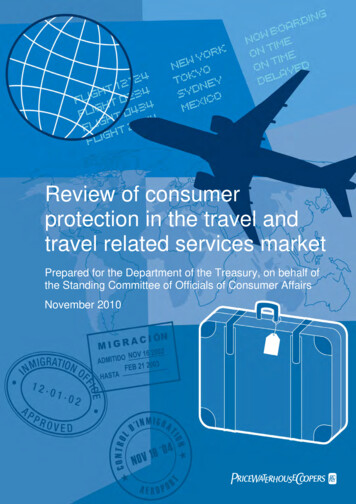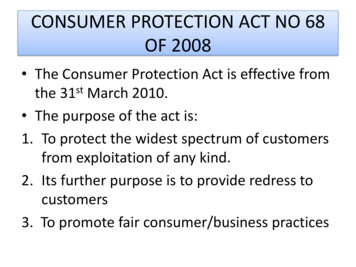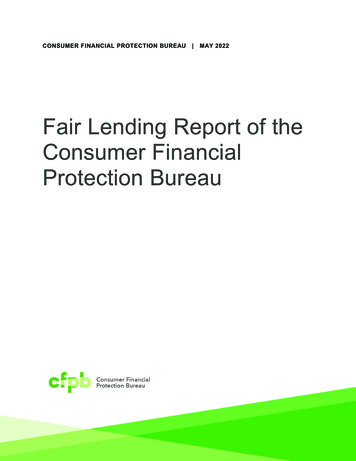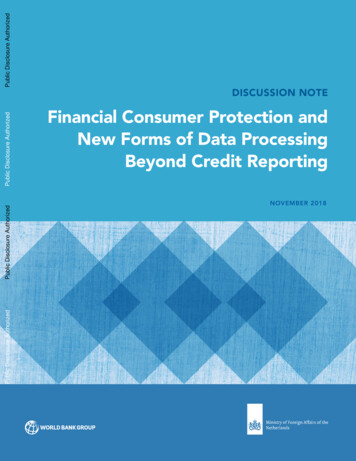
Transcription
Public Disclosure AuthorizedPublic Disclosure AuthorizedPublic Disclosure AuthorizedPublic Disclosure AuthorizedDISCUSSION NOTEFinancial Consumer Protection andNew Forms of Data ProcessingBeyond Credit ReportingNOVEMBER 2018
Finance, Competitiveness & Innovation Global Practice 2018 International Bank for Reconstruction and Development / The World Bank 1818 H Street NWWashington DC 20433 Telephone: 202-473-1000 Internet: www.worldbank.orgThis work is a product of the staff of The World Bank with external contributions. The findings, interpretations,and conclusions expressed in this work do not necessarily reflect the views of The World Bank, its Board ofExecutive Directors, or the governments they represent.The World Bank does not guarantee the accuracy of the data included in this work. The boundaries, colors,denominations, and other information shown on any map in this work do not imply any judgment on thepart of The World Bank concerning the legal status of any territory or the endorsement or acceptance ofsuch boundaries.RIGHTS AND PERMISSIONSThe material in this work is subject to copyright. Because The World Bank encourages dissemination of itsknowledge, this work may be reproduced, in whole or in part, for noncommercial purposes as long as fullattribution to this work is given. Any queries on rights and licenses, including subsidiary rights, should beaddressed to World Bank Publications, The World Bank Group, 1818 H Street NW, Washington, DC 20433,USA; fax: 202-522-2625; e-mail: pubrights@worldbank.org
CONTENTSAcknowledgmentsAcronyms and Abbreviationsiiiii1INTRODUCTION12SCOPE AND DEFINITIONS33CONSUMERS’ VIEWS ON SHARING THEIR PERSONAL INFORMATION44 HOW USAGE OF NEW FORMS OF DATA IN FINANCIAL SERVICES BRINGSBENEFITS TO CONSUMERS55 INTERNATIONAL STANDARDS RELEVANT TO BIG DATA AND FINANCIALCONSUMER PROTECTION65.15.25.3Core Financial Consumer Protection PrinciplesPrivacy and Data ProtectionCredit Reporting6 FINANCIAL CONSUMER PROTECTION PRINCIPLES, NEW FORMS OF DATACHALLENGES, ISSUES, AND RISKS6.16.26.36.46.56.67ConsentProduct and Price Segmentation and Potential DiscriminationComparability of Financial Services and ProductsSecurityAccuracy and Reliability of DataCrossborder Data FlowsCONCLUSION7891212131516171719BOXES AND FIGURESBox 1Emerging Approaches to Address Consent-Related IssuesBox 2Insurance, an Area Where Big Data Could Become a Potential Source of DiscriminationBox 3 Recently Issued Regulations and Guidance That Address Concerns about the Usage of NewTypes of Data from Multiple Sources1416Figure 1 The General Principles for Credit ReportingFigure 2 Mobile Scoring Methodology101018i
ACKNOWLEDGMENTSThis discussion note is a product of the Financial Inclusion, Infrastructure & Access Unit in the WorldBank Group’s Finance, Competitiveness & Innovation Global Practice. The note was prepared byRosamund Clare Grady, Fredesvinda Fatima Montes, and Marco Traversa. Douglas Pearce providedoverall guidance.The team is grateful for peer review comments received by Margaret Miller and David Medine.The team benefited from discussion and consultation papers, and from presentations and discussions at events and conferences, including the Responsible Finance Forum VIII (April 2017) and theConsultative Group to Assist the Poor and International Telecommunications Union’s joint data-privacy and digital-finance workshop, “Two Data-Driven Financial Inclusion Business Models andImplications for Data Privacy” (April 2016). The team gratefully acknowledges useful commentsreceived from members of the International Committee on Credit Reporting (ICCR), the International Financial Consumer Protection Organistion (FinCoNet), and the G20-OECD Task Force onFinancial Consumer Protection.The team thanks Naylor Design, Inc. for design and layout assistance, and Charles Hagner for editorial inputs.Finally, this report would not be possible without the generous support of the Netherlands’ Ministryof Foreign Affairs.ii
ACRONYMS AND ABBREVIATIONSAPECAsia-Pacific Economic CooperationARCOaccess, rectification, correction, and oppositionDFSdigital financial servicesFCPfinancial consumer protectionG20Group of TwentyG20 DFI HLPsG20 High-Level Principles for Digital Financial InclusionG20 FCP HLPsG20 High-Level Principles on Financial Consumer ProtectionGeneral PrinciplesGeneral Principles for Credit ReportingGood PracticesGood Practices for Financial Consumer ProtectionGSMAGSM AssociationITUInternational Telecommunications UnionKYCKnow Your CustomerOECD Guidelines OECD Guidelines on the Protection of Privacy and TransborderFlows of Personal Dataiii
1 INTRODUCTIONThe objective of this discussion note is to provide anoverview of consumer-related benefits and risks arisingfrom the usage of new types of data, beyond traditionalcredit-reporting frameworks, for the provision of financialservices, while also aiming at identifying areas for furtherresearch. The note was developed primarily by synthesizing discussions about new forms of data—including bigdata–related financial consumer protection (FCP) issues—both in the various international forums in which theWorld Bank Group is represented and in consultation anddiscussion papers. Special regard has been given to thelikely benefits and risks for consumers in developing countries and emerging markets. Consideration has also beengiven to international FCP standards and good practices.analytics, many other types of new data, beyond traditional credit-reporting frameworks, are currently beingused and processed for the provision of financial services.Technological innovation in the financial sector is a globaland rapidly growing phenomenon, with particular relevance for developing economies and emerging markets.The use of new technologies is changing how financialproducts and services are being designed and delivered,vastly increasing the potential number of users by allowing for access even in remote, rural locations while reducing the cost of services. These innovations are especiallyrelevant for developing economies and emerging markets, encouraging them to embrace digital financial-inclusion strategies, with all their potential for economicgrowth and poverty reduction.1 Create credit scores for consumers without a formalcredit history or with limited credit hiostry;A key part of this technological innovation is the usage ofnew types of data and data-processing tools, including bigdata, in the provision of financial services. While the mosttalked-about issue is “big data,” focusing on data sets thatare characterized by exponential growth in volume, variety, and velocity and that are the subject of advanced data1. Arjuna Costa, Anamitra Deb, and Michael Kubzansky, “BigData, Small Credit: The Digital Revolution and Its Impact onEmerging Market Consumers” (Omidyar Network, 2016), 6.See also Tavneet Suri and William Jack, “The Long-RunPoverty and Gender Impacts of Mobile Money,” Science 354,no. 6317 (December 9, 2016), 1288–1292.New technologies, combined with the usage and processing of new types of small-, medium-, and large-volumedata, can support financial inclusion and bring benefits tofinancial consumers. New sources of data, as well as newways of processing such data, are a key contributor to theexplosion in the accessibility of convenient and tailoreddigital financial services (DFS) to served, underserved, andunserved consumers. They are being used to; Design and market “consumer-centric” (digital) financial services for the unbanked; Meet and facilitate compliance with “Know Your Customer” (KYC) requirements; Price financial services to reflect the risk profile of individual consumers; and Minimize the risk of fraud.On the other hand, issues may arise, as there is a greatvariety of personal information that may be used and processed in this context. First, traditional financial servicesproviders generally have access to conventional forms ofhighly organized, readily searchable, structured data,including client data—credit history and scores, IDs,demographics, and survey data—as well as transactionaldata. Second, technological advancements allow theusage of other forms of data that are new in the sense thatthey either have not (until recent times) been used byfinancial services providers or are not necessarily relatedto the use of financial services. They include, for example,social-media data and data about the usage of e-money,air time, online search and shopping habits, utility payments, psychometric data, Internet-based entertainmentservices, devices connected to the Internet of Things, and1
2 Financial Consumer Protection and New Forms of Data Processing Beyond Credit Reportingdata used to determine insurance-related risks. The powerof some of this data—such as information on businesscash-flow and sales history, which is available throughe-commerce platforms—has created opportunities fornew entrants to financial services. Some of these “newtypes of data” may also be unstructured (such as emails,texts, audio files, digital pictures, videos, and messages).And, finally, public sources of data are also available fromcourts and bankruptcy records, all forms of media, andelectoral rolls, which could also be exploited and takeninto consideration in big-data analytics.Given the lack of a framework, risks for financial consumers are growing in nature and scale as the use of thesenew types of data expands. The recent increase in theaggregation and analysis of huge volumes of diverselysourced personal information, and the speed with which itis processed, create the risk that individuals will be definedby reference only to data and algorithms, rather than personal information. More specifically, key risks include thefollowing: uninformed and meaningless consumer consent to the use of personal information; illegal discrimination; unfair price segmentation; lack of transparency aboutthe collection, use, and disclosure of personal information; insufficient data security (the greater the volume ofdata being stored, the greater the risks); and failure toprovide effective access and correction and complaints-handling mechanisms. The potential for these risksto cause harm is greater where consumers have low levelsof financial capability, as is the case in many developingeconomies and emerging markets.A further factor affecting the growth of benefits and risksis the rapidly expanding use of smartphones to deliverDFS. As of December 2016, there were around 2 billionsmartphones globally, and this number is expected to riseto 4 billion by 2020, with much of the growth in emergingmarkets and developing economies.2 This growth isfueled largely by the decreasing cost of smartphones,which generate valuable data that can facilitate cheaper,more tailored financial services, and many economies arerecognizing this potential.3Given the increased usage of new types of small-, medium-,and large-volume data and considering its potential benefits and risks, there has been growing international focuson this phenomenon. The Group of Twenty (G20), theWorld Bank’s Finance and Markets Global Practice, theBank for International Settlements, the Consultative Groupto Assist the Poor, the Better Than Cash Alliance, the U.S.Consumer Financial Protection Bureau, the GSM Association (GSMA), the European Banking Authority, and theInternational Monetary Fund, among others, have provided guidance and launched workstreams on this topic.For example, the GSMA’s Code of Conduct for MobileMoney addresses transparency of data, user choice andcontrol, data minimization, fraud management, and security.4 The Better Than Cash Alliance’s Digital PaymentsGuidelines also call for clients’ digital data to be kept confidential and secure.5 Importantly, the G20 High-LevelPrinciples for Digital Financial Inclusion (G20 DFI HLPs)state: “Digital technology also enables the generation andanalysis of vast amounts of customer and transaction data(‘Big Data’), which introduces its own set of benefits andrisks that should be managed.”6While there is existing guidance on the use of personaldata and recognized financial consumer rights in existingframeworks and international standards, there is a need toexamine the frameworks and their adequacy in relation tothis phenomenon in the financial sector. Relevant issuesmay include those relating to consumer and data protection, privacy, credit reporting, competition, and discrimination. In addition, sectoral standards and regulationscovering aspects of payment systems, credit information,and data analytics might also include provisions on themassive use of data from different sources. Generally,robust data-protection standards cover only some of theseissues, and even where such standards are robust, a keyaspect to consider is the implementation of existing rulesand principles, particularly relating to FCP, data privacy,and credit reporting, in the context of big data. Finally,beyond the application of rules and principles, this phenomenon poses challenges to responsible authoritiesboth within the national context and internationally andrequires firm collaboration between them,7 as even whereregulatory frameworks exist, issues are likely to stretch thesupervisory capacity of relevant regulators.4. Code of Conduct for Mobile Money Providers, Principle 8 (GSMA,2015), available at -Providers-V2.pdf5. Responsible Digital Payments Guidelines, Guideline 7 (Better ThanCash Alliance, 2016), available at �� See, for example, ging-ems-business-landscape6. G20 High-Level Principles for Digital Financial Inclusion, Principle5 (Global Partnership for Financial Inclusion, 2016), available -principlesdigital-financial-inclusion.3. See, for example, recommendations from the various committeesof the Government and Reserve Bank of India, which are workingon financial inclusion and recommending linking data generatedby unique personal identifiers to credit bureaus.7. See, for example, “Joint Committee Discussion Paper on the Useof Big Data by Financial Institutions,” (European Securities andMarkets Authority, European Banking Authority, and EuropeanInsurance and Occupational Pensions Authority, 2016).
Financial Consumer Protection and New Forms of Data Processing Beyond Credit Reporting 32 SCOPE AND DEFINITIONSIn recent years, financial services providers have begunusing and processing different types of data to makefinancial services and products more cost-efficient and tailored to consumers’ needs. Given new technologicaladvancements, including the advent of FinTech, and theuptake in electronic transactions and electronic commerce, more and more consumers are generating datathat is in turn being processed and used by financial services providers and FinTech. While no single definition ofdata is used, it can include small, medium, and big data,as well as both unstructured and structured data. It can bedata on electronic payments or remittances recipients, aswell as social-media data and other types of data, including Internet searches, online shopping, and so forth. Theissues presented in this background document cover alltypes of data and are not limited just to big data, althoughgiven its complexity, it deserves special attention.Given big data’s increased relevance, continued usage,and complexity, and considering that definitions vary acrosssectors, regulatory bodies, and countries, it is importantto define big data before commencing the analysis.Definitions typically focus on the three Vs—the volume,velocity, and variety of the collected data and the relatedadvanced processing techniques. The Gartner definitionis often quoted in this context: “Big data is high-volume,high-velocity and/or high-variety information assets thatdemand cost-effective, innovative forms of informationprocessing that enable enhanced insight, decision makingand process automation.”8 Governments and regulatoryauthorities have adopted and used similar definitions.Below is a more detailed explanation of the three Vs:9 Volume. Although there are diverging views about thetotal volume of new data created on the web, an oftencited estimate is that at least 2.5 exabytes are generated every day, and it’s predicted that 40 zettabyteswill be created by 2020.10 This shows that an immenseamount of data is being produced and accumulated,and that the amount is growing very rapidly. Velocity. This refers to the rate at which data is generated. Variety. This term refers to the wide range of databeing collected, analyzed, and used. Examples includetraditional data from financial transactions as well asdata from social-media networks, psychometric testing,air-time usage, mobile phone and email communica8. See “Big Data” in the Gartner IT Glossary, available at http://www.gartner.com/it-glossary/big-data. See also s/Discussion%20Paper/jc-2016-86 discussion paper big data.pdftions, chat sites, online shopping habits and transactionhistories, gaming sites, use of Internet-based entertainment services, virtual currency transactions, utility payments, and data from the Internet of Things. Informationon shipping and delivery times, consumer reviews,complaints data, mobile money transaction volumes,and other data relevant to small businesses run by individuals is also relevant.Beyond the three Vs, big data is also characterized byadvanced data analytics and related algorithms. Examplesinclude using algorithms to find correlations in a form ofmachine learning; collecting and analyzing all availabledata, rather than, for example, sampling the availabledata randomly; and repurposing data—that is, using dataprovided for one purpose for another (using social-mediadata for marketing purposes, for example).11Additionally, the term big data covers both structured andunstructured data. Unstructured data has been usefullydefined as “referring to information that either does nothave a pre-defined data model and/or is not organized ina predefined manner.”12 Examples given include emails,text files, audio files, presentations, digital pictures andvideos, images and messaging, as well as potentially theunderlying sources of metadata.13 Structured data, on theother hand, has been defined as (in summary) “information with a high degree of organization, such that inclusionin a relational database is seamless and readily searchableby simple, straightforward search-engine algorithms orother search operations.”14For the purpose of this document, the consumer is understood as a person or a micro- and/or small enterprisewhose data may be collected, used, and disclosed forpersonal or business purposes.9. See, for example, the definition used in “Joint CommitteeDiscussion Paper.”10. To put this in context, an exabyte has been estimated as 1 trillion,600 billion books, or about 3,000 times the content of the Libraryof Congress. Another statistic to note: By 2025, there could be upto 75.4 billion devices connected to the Internet (up from 15.4billion in 2015). Louis Columbus, “Roundup of Internet of ThingsForecasts and Market Estimates, 2016,” Forbes, November 27,2016, available at ket-estimates-2016/#b65fac4292d511. “Big Data and Data Protection” (Information Commissioner’sOffice, 2014), 9.12. Michelle Nemschoff, “A Quick Guide to Structured andUnstructured Data,” Smart Data Collective, June 28, 2014,available at ata.13. Nemschoff, 2014.14. “Structured vs. Unstructured Data,” BrightPlanet, June 28, 2012,available at unstructured-data/.
4 Financial Consumer Protection and New Forms of Data Processing Beyond Credit Reporting3 CONSUMERS’ VIEWS ON SHARINGTHEIR PERSONAL INFORMATIONWhile the usage of new and different form of data maybring advantages for financial inclusion and enhanceproduct suitability, recently conducted surveys suggestthat consumers have different attitudes toward sharingpersonal information to receive a better offer. Surveysconducted by the Boston Consulting Group, GSMA, theInternational Telecommunications Union (ITU), and theOmidyar Network show that, overall, consumers careabout their data. Despite this, they are often likely toconsent to sharing their data without reading the termsand conditions first, and the extent to which they maybe willing to share certain types of information variessignificantly.As consumers are asked more and more often to sharetheir data, it can be inferred that, while they consider certain data private and sensitive, the majority believes thatsharing is part of everyday life. A Boston Consulting Groupsurvey conducted in 201315 showed that consumers seedata related to their phone and financial-services usage asmoderately to extremely private (89 percent and 65 percent, respectively), but less than 50 percent of consumerssee social-network data and information about purchasesas moderately to extremely private. Having this in mind,78 percent of consumers understand that sharing data ispart of everyday life.A similar survey focused specifically on mobile Internetusage.16 It showed that while most consumers are concerned about sharing their data, a smaller proportion willcheck what information is required to be shared andrelated policies and procedures before installing an application. However, a significant number of consumers wouldlike to have consistent data-protection and privacy-relatedrules. In fact, according to the survey, over 80 percent ofmobile Internet users worldwide had concerns about sharing their personal information when accessing mobileapplications and services. This number dropped to 65percent when only those mobile-application users whocheck what information an application wants to accesswere taken into consideration. Similarly, 81 percent ofmobile users think it is important to be informed and tohave the option of agreeing each time their personal15. BCG Global Consumer Sentiment Survey, 2013 (BostonConsulting Group, 2013). The survey was conducted in fiveEuropean countries (Germany, France, Italy, Spain, and theUnited Kingdom).16. “Mobile Privacy: Consumer Research Insights and Considerations for Policymakers” (GSMA, February 2014), available licymakers.information is shared with third parties. Nevertheless,most mobile-application users with privacy concerns (52percent) would still use the application. Lastly, 60 percentof mobile users want a consistent set of rules to apply toany company accessing their location, regardless of howthey obtain this information.17Another survey, conducted in 2016 by the Omidyar Network, showed that more and more consumers use theirphones to make financial transactions and consider phoneusage–related data as personal and sensitive. In selecteddeveloping economies, a high number of consumers,over 30 percent, use their phones to make financial transactions, and over 80 percent consider emails, calls, andtexts as personal and sensitive data, while over 70 percentconsider financial and medical data as private. Interestingly, in order to get a loan more easily, 70 percent ofconsumers would share data on mobile-phone usage andbank accounts, but only 60 percent would be willing toshare data on social-media activity. Overall, as for the2014 GSMA survey, 80 percent believe that the existenceand adoption of good, clear policies and procedures governing data privacy would increase their trust in a financialinstitution.Finally, the recommendations of the March 2017 ITU-TFocus Group on Digital Financial Services also noted consumer concerns about the sensitivity of their financialinformation.18 The research referred to by the ITU indicates that consumers have concerns about how their information will be used and shared, and fear that it mayexpose them to “identity theft, embarrassment, and tax orcriminal liability.”19 However, the report also notes thatconsumer attitudes vary from country to country.20Although consumers’ behaviors and attitudes toward thesharing of information vary from one jurisdiction toanother, some trends can be highlighted. The above surveys suggest the following trends: (i) Consumers generallysee data related to the usage of financial services andphones as sensitive. (ii) Nevertheless, they will not necessarily check privacy policies and forms of consent beforeaccessing DFS. Finally, (iii) there is a demand for clarity andconsistency in applicable rules and policies.17. See, generally, the overall results of the survey in “MobilePrivacy.”18. ITU-T Focus Group on Digital Financial Services, “ConsumerExperience and Protection Recommendations,” chapter 5 of ITUFocus Group Digital Financial Services: Main Recommendations(ITU, 2017), available at nts/201703/ITU FGDFS MainRecommendations.pdf19. ITU-T Focus Group on Digital Financial Services.20. ITU-T Focus Group on Digital Financial Services.
Financial Consumer Protection and New Forms of Data Processing Beyond Credit Reporting 54 HOW USAGE OF NEW FORMSOF DATA IN FINANCIAL SERVICESBRINGS BENEFITS TO CONSUMERSThis section analyzes the different ways in which newforms of data have been used and how they have beenbeneficial to consumers of financial services. New typesof data, in particular big data, and the related analyticsprovide financial services firms with new opportunities touse greatly expanded data sets, and to combine historical data with real-time data when designing and marketing financial products. The potential benefits arenumerous. Examples include the following: use of bigdata by financial services providers for client profiling;21putting in place better market-segmentation practices;assessing credit risk, including scoring models;22 identifying and mitigating risks and delivering more tailoredproducts;23 assessing and preventing fraud in insuranceclaims;24 and, finally, facilitating compliance with regulatory requirements, including meeting KYC compliancerequirements.25As mentioned, the increased uptake of mobile phonesand electronic financial services is generating an enormous amount of data. Not only does this provide newmultiple data sources, but the large volume enables bigdata analytics that in turn can be used to identify consumer behaviors better and to monitor and prevent fraud.As identified by several reports and studies,26 electronic-payment transactions have increased substantially overthe years. This trend is expected only to increase as21. Examples of new client-profiling technologies include KopaCash, which provides mobile phone–based loan approvals toM-Pesa account holders within minutes and advises on itswebsite that social media is used in its operations. Nedbankmakes widespread use of social-media analytics to enhancethe experience of its banking customers.22. Examples include Sesame Credit Management, which createscredit scores for consumers and small businesses; Kreditech,which processes more than 20,000 data points per applicationusing artificial intelligence built into private credit-scoringtechnology; Cignifi, which uses mobile-phone data, messages,and payments information to create credit scores; and Lenddo,which allows an organization to use its presence on socialnetworks such as Facebook, LinkedIn, Google, Yahoo, andTwitter to prove its identity and creditworthiness.23. See forever/#7008b703289b24. The South African insurer Santam has developed a new, fastersystem for processing claims based on big data to score claimsfor fraud risk.25. Tradle in the United States uses block-chain technology tobridge internal and external financial networks to accomplishuser-controller KYC portability or Trulioo.26. See “Global Payment Systems Survey 2015: Accounts andAccess” (World Bank Group, 2016), available at /GPSS-UFA-NoteOctober2016.pdfnational authorities, governments, and regulators act proactively to increase the usage of electronic payments (forexample, through the digitization of certain large-volumepayment streams) and financial inclusion.27 For example,banks in Indonesia and Hong Kong use predictive modeling to identify potential fraud and alert consumers almostinstantly.28 The analysis looks at either the “purchaserelated data” or customers’ habits and behaviors.This phenomenon further allows markets and consumersto be analyzed ever more precisely, using millions of datapoints, and for increasingly tailored financial services andprices to be offered to consumers. For example, financialservices providers can use all this new data to assess theproduct needs of a consumer, his or her risk profile andfinancial means, and even to establish whether a consumer may be willing to pay more for a given product thanother consumers. Products and services can thus bedesigned to suit the needs of individual customers better,and offerings can be priced on an individual-risk basis.Further, one of the most frequently cited and commonadvantages brought by analytics of this data is the possibility of developing credit scores for people who are notcovered by traditional credit information systems, such ascredit bureaus or credit registries. While access to credit“is a critical element of private sector–led growth,”29according to the Global Findex only 11 percent of theworld’s adul
Principles for Digital Financial Inclusion (G20 DFI HLPs) state: "Digital technology also enables the generation and analysis of vast amounts of customer and transaction data ('Big Data'), which introduces its own set of benefits and risks that should be managed."6 While there is existing guidance on the use of personal
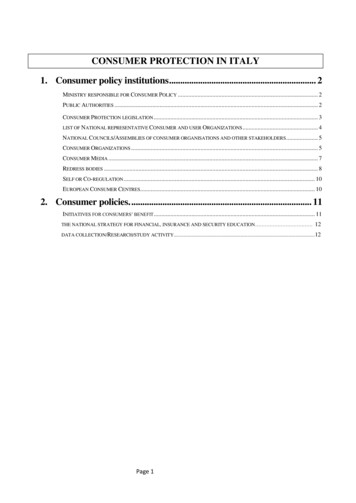
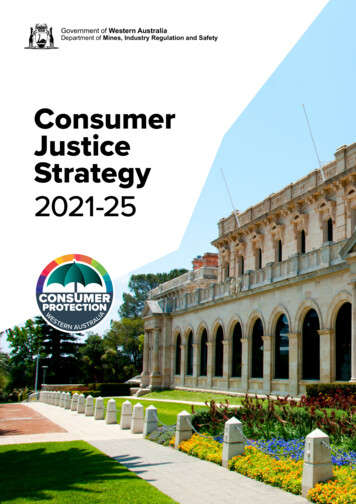

![Chapter 11. Consumer Protection. [Note] - Montgomery County, Maryland](/img/40/chap11.jpg)
